LLM LAWS912: Image Rights as Intellectual Property and Human Rights
VerifiedAdded on 2023/06/09
|21
|8848
|404
Essay
AI Summary
This essay examines the complex relationship between image rights, intellectual property rights, and human rights. It delves into the definition and legislation surrounding image rights, contrasting them with copyright law and exploring the human rights implications of treating image rights as intellectual property. The essay covers international agreements like TRIPs and the Universal Declaration of Human Rights, analyzing relevant legal frameworks and moral rights. It also discusses the rights of both photographers and individuals whose images are being used, considering privacy laws and relevant national legislation. The conclusion offers recommendations for balancing intellectual property protection with the fundamental principles of human rights. This document is available on Desklib, a platform offering a range of study tools and resources for students.
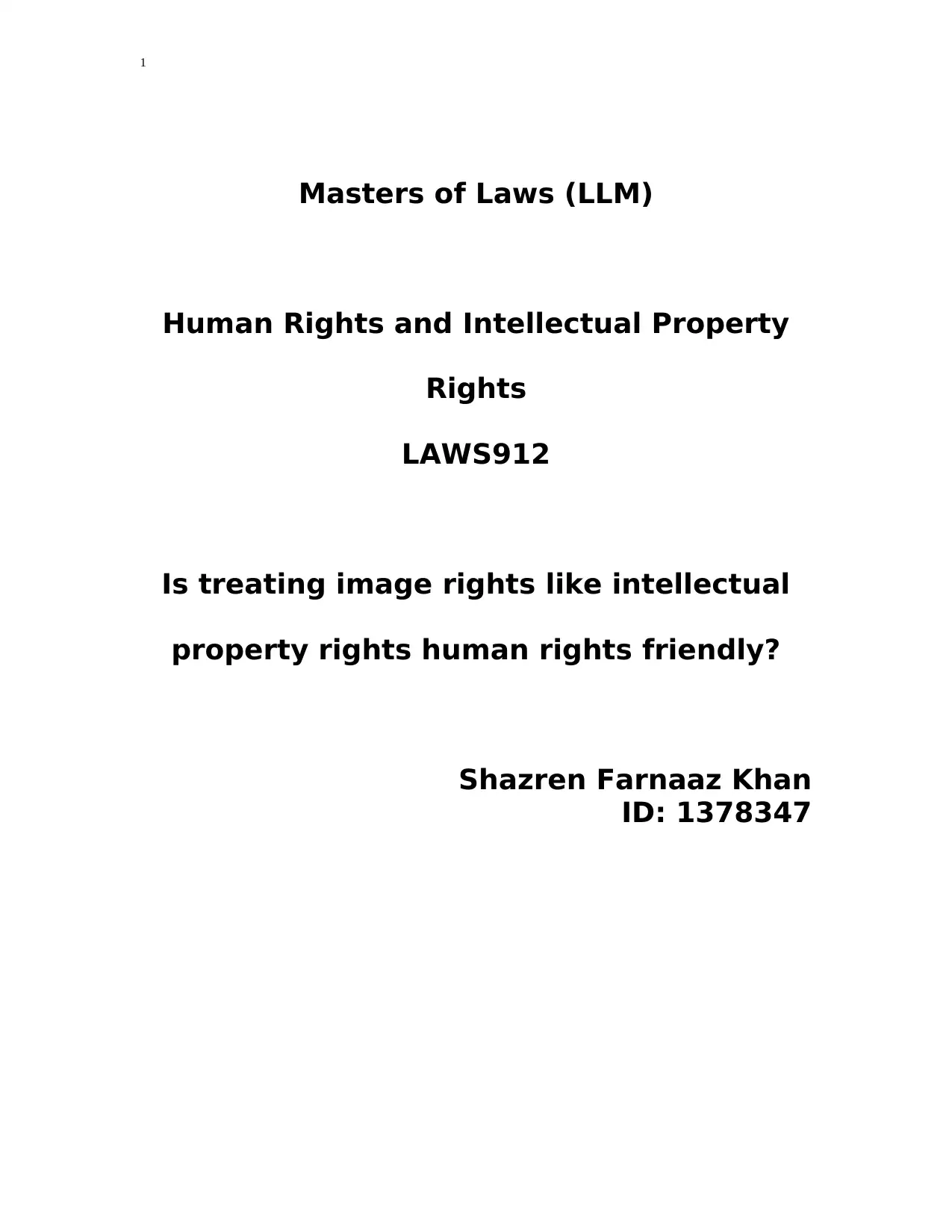
1
Masters of Laws (LLM)
Human Rights and Intellectual Property
Rights
LAWS912
Is treating image rights like intellectual
property rights human rights friendly?
Shazren Farnaaz Khan
ID: 1378347
Masters of Laws (LLM)
Human Rights and Intellectual Property
Rights
LAWS912
Is treating image rights like intellectual
property rights human rights friendly?
Shazren Farnaaz Khan
ID: 1378347
Paraphrase This Document
Need a fresh take? Get an instant paraphrase of this document with our AI Paraphraser
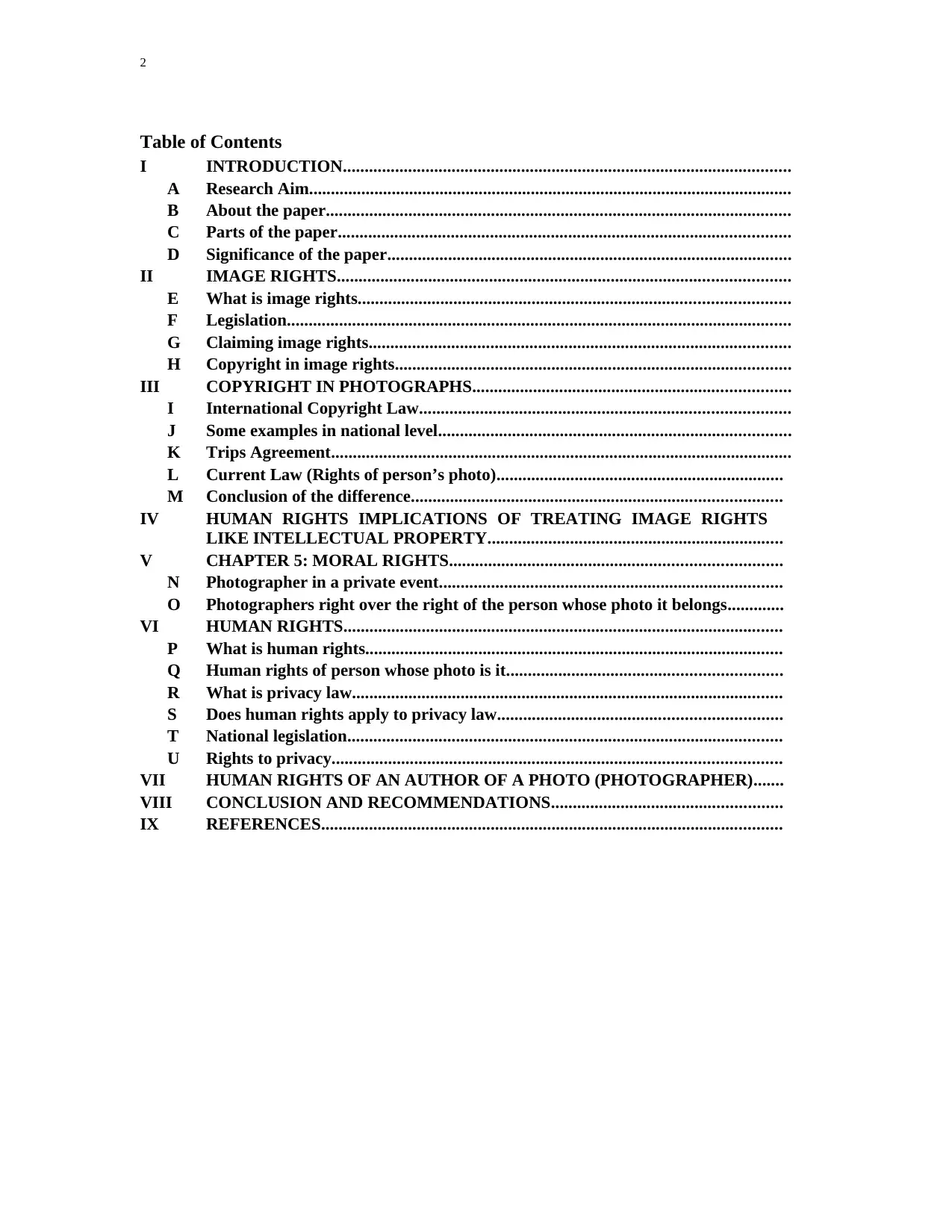
2
Table of Contents
I INTRODUCTION.......................................................................................................
A Research Aim...............................................................................................................
B About the paper...........................................................................................................
C Parts of the paper........................................................................................................
D Significance of the paper.............................................................................................
II IMAGE RIGHTS........................................................................................................
E What is image rights...................................................................................................
F Legislation....................................................................................................................
G Claiming image rights.................................................................................................
H Copyright in image rights...........................................................................................
III COPYRIGHT IN PHOTOGRAPHS.........................................................................
I International Copyright Law.....................................................................................
J Some examples in national level.................................................................................
K Trips Agreement..........................................................................................................
L Current Law (Rights of person’s photo)..................................................................
M Conclusion of the difference.....................................................................................
IV HUMAN RIGHTS IMPLICATIONS OF TREATING IMAGE RIGHTS
LIKE INTELLECTUAL PROPERTY....................................................................
V CHAPTER 5: MORAL RIGHTS............................................................................
N Photographer in a private event...............................................................................
O Photographers right over the right of the person whose photo it belongs.............
VI HUMAN RIGHTS.....................................................................................................
P What is human rights................................................................................................
Q Human rights of person whose photo is it...............................................................
R What is privacy law...................................................................................................
S Does human rights apply to privacy law.................................................................
T National legislation....................................................................................................
U Rights to privacy.......................................................................................................
VII HUMAN RIGHTS OF AN AUTHOR OF A PHOTO (PHOTOGRAPHER).......
VIII CONCLUSION AND RECOMMENDATIONS.....................................................
IX REFERENCES..........................................................................................................
Table of Contents
I INTRODUCTION.......................................................................................................
A Research Aim...............................................................................................................
B About the paper...........................................................................................................
C Parts of the paper........................................................................................................
D Significance of the paper.............................................................................................
II IMAGE RIGHTS........................................................................................................
E What is image rights...................................................................................................
F Legislation....................................................................................................................
G Claiming image rights.................................................................................................
H Copyright in image rights...........................................................................................
III COPYRIGHT IN PHOTOGRAPHS.........................................................................
I International Copyright Law.....................................................................................
J Some examples in national level.................................................................................
K Trips Agreement..........................................................................................................
L Current Law (Rights of person’s photo)..................................................................
M Conclusion of the difference.....................................................................................
IV HUMAN RIGHTS IMPLICATIONS OF TREATING IMAGE RIGHTS
LIKE INTELLECTUAL PROPERTY....................................................................
V CHAPTER 5: MORAL RIGHTS............................................................................
N Photographer in a private event...............................................................................
O Photographers right over the right of the person whose photo it belongs.............
VI HUMAN RIGHTS.....................................................................................................
P What is human rights................................................................................................
Q Human rights of person whose photo is it...............................................................
R What is privacy law...................................................................................................
S Does human rights apply to privacy law.................................................................
T National legislation....................................................................................................
U Rights to privacy.......................................................................................................
VII HUMAN RIGHTS OF AN AUTHOR OF A PHOTO (PHOTOGRAPHER).......
VIII CONCLUSION AND RECOMMENDATIONS.....................................................
IX REFERENCES..........................................................................................................
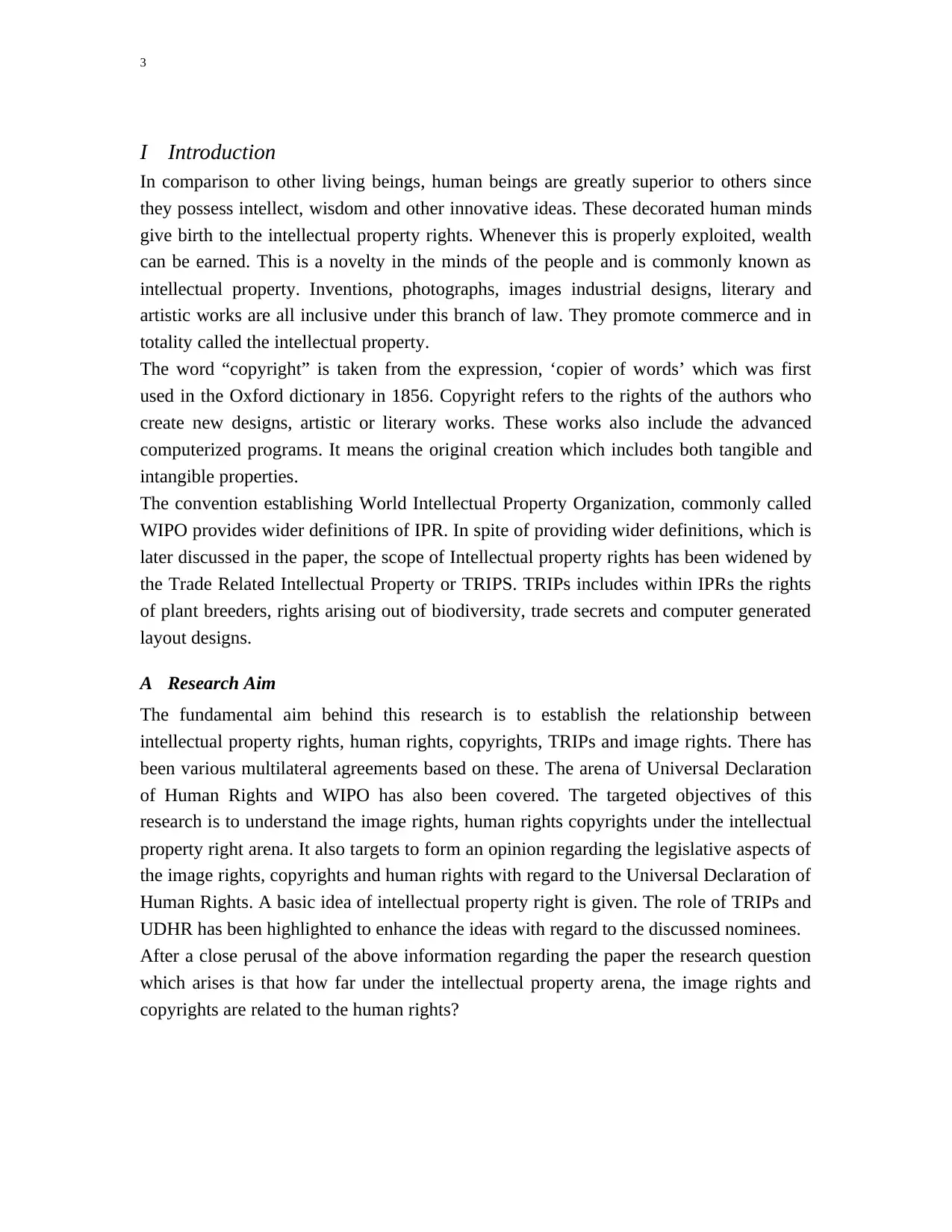
3
I Introduction
In comparison to other living beings, human beings are greatly superior to others since
they possess intellect, wisdom and other innovative ideas. These decorated human minds
give birth to the intellectual property rights. Whenever this is properly exploited, wealth
can be earned. This is a novelty in the minds of the people and is commonly known as
intellectual property. Inventions, photographs, images industrial designs, literary and
artistic works are all inclusive under this branch of law. They promote commerce and in
totality called the intellectual property.
The word “copyright” is taken from the expression, ‘copier of words’ which was first
used in the Oxford dictionary in 1856. Copyright refers to the rights of the authors who
create new designs, artistic or literary works. These works also include the advanced
computerized programs. It means the original creation which includes both tangible and
intangible properties.
The convention establishing World Intellectual Property Organization, commonly called
WIPO provides wider definitions of IPR. In spite of providing wider definitions, which is
later discussed in the paper, the scope of Intellectual property rights has been widened by
the Trade Related Intellectual Property or TRIPS. TRIPs includes within IPRs the rights
of plant breeders, rights arising out of biodiversity, trade secrets and computer generated
layout designs.
A Research Aim
The fundamental aim behind this research is to establish the relationship between
intellectual property rights, human rights, copyrights, TRIPs and image rights. There has
been various multilateral agreements based on these. The arena of Universal Declaration
of Human Rights and WIPO has also been covered. The targeted objectives of this
research is to understand the image rights, human rights copyrights under the intellectual
property right arena. It also targets to form an opinion regarding the legislative aspects of
the image rights, copyrights and human rights with regard to the Universal Declaration of
Human Rights. A basic idea of intellectual property right is given. The role of TRIPs and
UDHR has been highlighted to enhance the ideas with regard to the discussed nominees.
After a close perusal of the above information regarding the paper the research question
which arises is that how far under the intellectual property arena, the image rights and
copyrights are related to the human rights?
I Introduction
In comparison to other living beings, human beings are greatly superior to others since
they possess intellect, wisdom and other innovative ideas. These decorated human minds
give birth to the intellectual property rights. Whenever this is properly exploited, wealth
can be earned. This is a novelty in the minds of the people and is commonly known as
intellectual property. Inventions, photographs, images industrial designs, literary and
artistic works are all inclusive under this branch of law. They promote commerce and in
totality called the intellectual property.
The word “copyright” is taken from the expression, ‘copier of words’ which was first
used in the Oxford dictionary in 1856. Copyright refers to the rights of the authors who
create new designs, artistic or literary works. These works also include the advanced
computerized programs. It means the original creation which includes both tangible and
intangible properties.
The convention establishing World Intellectual Property Organization, commonly called
WIPO provides wider definitions of IPR. In spite of providing wider definitions, which is
later discussed in the paper, the scope of Intellectual property rights has been widened by
the Trade Related Intellectual Property or TRIPS. TRIPs includes within IPRs the rights
of plant breeders, rights arising out of biodiversity, trade secrets and computer generated
layout designs.
A Research Aim
The fundamental aim behind this research is to establish the relationship between
intellectual property rights, human rights, copyrights, TRIPs and image rights. There has
been various multilateral agreements based on these. The arena of Universal Declaration
of Human Rights and WIPO has also been covered. The targeted objectives of this
research is to understand the image rights, human rights copyrights under the intellectual
property right arena. It also targets to form an opinion regarding the legislative aspects of
the image rights, copyrights and human rights with regard to the Universal Declaration of
Human Rights. A basic idea of intellectual property right is given. The role of TRIPs and
UDHR has been highlighted to enhance the ideas with regard to the discussed nominees.
After a close perusal of the above information regarding the paper the research question
which arises is that how far under the intellectual property arena, the image rights and
copyrights are related to the human rights?
⊘ This is a preview!⊘
Do you want full access?
Subscribe today to unlock all pages.

Trusted by 1+ million students worldwide
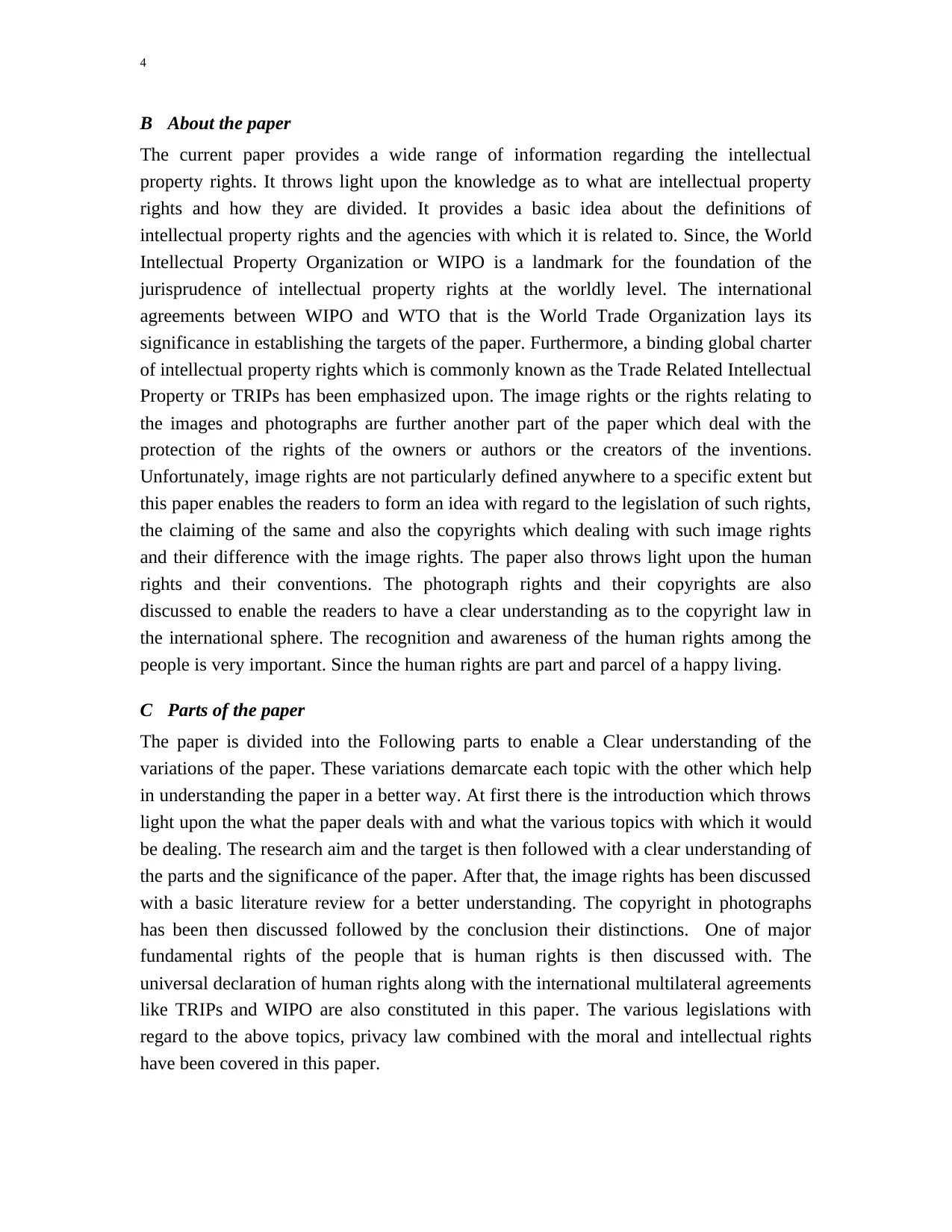
4
B About the paper
The current paper provides a wide range of information regarding the intellectual
property rights. It throws light upon the knowledge as to what are intellectual property
rights and how they are divided. It provides a basic idea about the definitions of
intellectual property rights and the agencies with which it is related to. Since, the World
Intellectual Property Organization or WIPO is a landmark for the foundation of the
jurisprudence of intellectual property rights at the worldly level. The international
agreements between WIPO and WTO that is the World Trade Organization lays its
significance in establishing the targets of the paper. Furthermore, a binding global charter
of intellectual property rights which is commonly known as the Trade Related Intellectual
Property or TRIPs has been emphasized upon. The image rights or the rights relating to
the images and photographs are further another part of the paper which deal with the
protection of the rights of the owners or authors or the creators of the inventions.
Unfortunately, image rights are not particularly defined anywhere to a specific extent but
this paper enables the readers to form an idea with regard to the legislation of such rights,
the claiming of the same and also the copyrights which dealing with such image rights
and their difference with the image rights. The paper also throws light upon the human
rights and their conventions. The photograph rights and their copyrights are also
discussed to enable the readers to have a clear understanding as to the copyright law in
the international sphere. The recognition and awareness of the human rights among the
people is very important. Since the human rights are part and parcel of a happy living.
C Parts of the paper
The paper is divided into the Following parts to enable a Clear understanding of the
variations of the paper. These variations demarcate each topic with the other which help
in understanding the paper in a better way. At first there is the introduction which throws
light upon the what the paper deals with and what the various topics with which it would
be dealing. The research aim and the target is then followed with a clear understanding of
the parts and the significance of the paper. After that, the image rights has been discussed
with a basic literature review for a better understanding. The copyright in photographs
has been then discussed followed by the conclusion their distinctions. One of major
fundamental rights of the people that is human rights is then discussed with. The
universal declaration of human rights along with the international multilateral agreements
like TRIPs and WIPO are also constituted in this paper. The various legislations with
regard to the above topics, privacy law combined with the moral and intellectual rights
have been covered in this paper.
B About the paper
The current paper provides a wide range of information regarding the intellectual
property rights. It throws light upon the knowledge as to what are intellectual property
rights and how they are divided. It provides a basic idea about the definitions of
intellectual property rights and the agencies with which it is related to. Since, the World
Intellectual Property Organization or WIPO is a landmark for the foundation of the
jurisprudence of intellectual property rights at the worldly level. The international
agreements between WIPO and WTO that is the World Trade Organization lays its
significance in establishing the targets of the paper. Furthermore, a binding global charter
of intellectual property rights which is commonly known as the Trade Related Intellectual
Property or TRIPs has been emphasized upon. The image rights or the rights relating to
the images and photographs are further another part of the paper which deal with the
protection of the rights of the owners or authors or the creators of the inventions.
Unfortunately, image rights are not particularly defined anywhere to a specific extent but
this paper enables the readers to form an idea with regard to the legislation of such rights,
the claiming of the same and also the copyrights which dealing with such image rights
and their difference with the image rights. The paper also throws light upon the human
rights and their conventions. The photograph rights and their copyrights are also
discussed to enable the readers to have a clear understanding as to the copyright law in
the international sphere. The recognition and awareness of the human rights among the
people is very important. Since the human rights are part and parcel of a happy living.
C Parts of the paper
The paper is divided into the Following parts to enable a Clear understanding of the
variations of the paper. These variations demarcate each topic with the other which help
in understanding the paper in a better way. At first there is the introduction which throws
light upon the what the paper deals with and what the various topics with which it would
be dealing. The research aim and the target is then followed with a clear understanding of
the parts and the significance of the paper. After that, the image rights has been discussed
with a basic literature review for a better understanding. The copyright in photographs
has been then discussed followed by the conclusion their distinctions. One of major
fundamental rights of the people that is human rights is then discussed with. The
universal declaration of human rights along with the international multilateral agreements
like TRIPs and WIPO are also constituted in this paper. The various legislations with
regard to the above topics, privacy law combined with the moral and intellectual rights
have been covered in this paper.
Paraphrase This Document
Need a fresh take? Get an instant paraphrase of this document with our AI Paraphraser
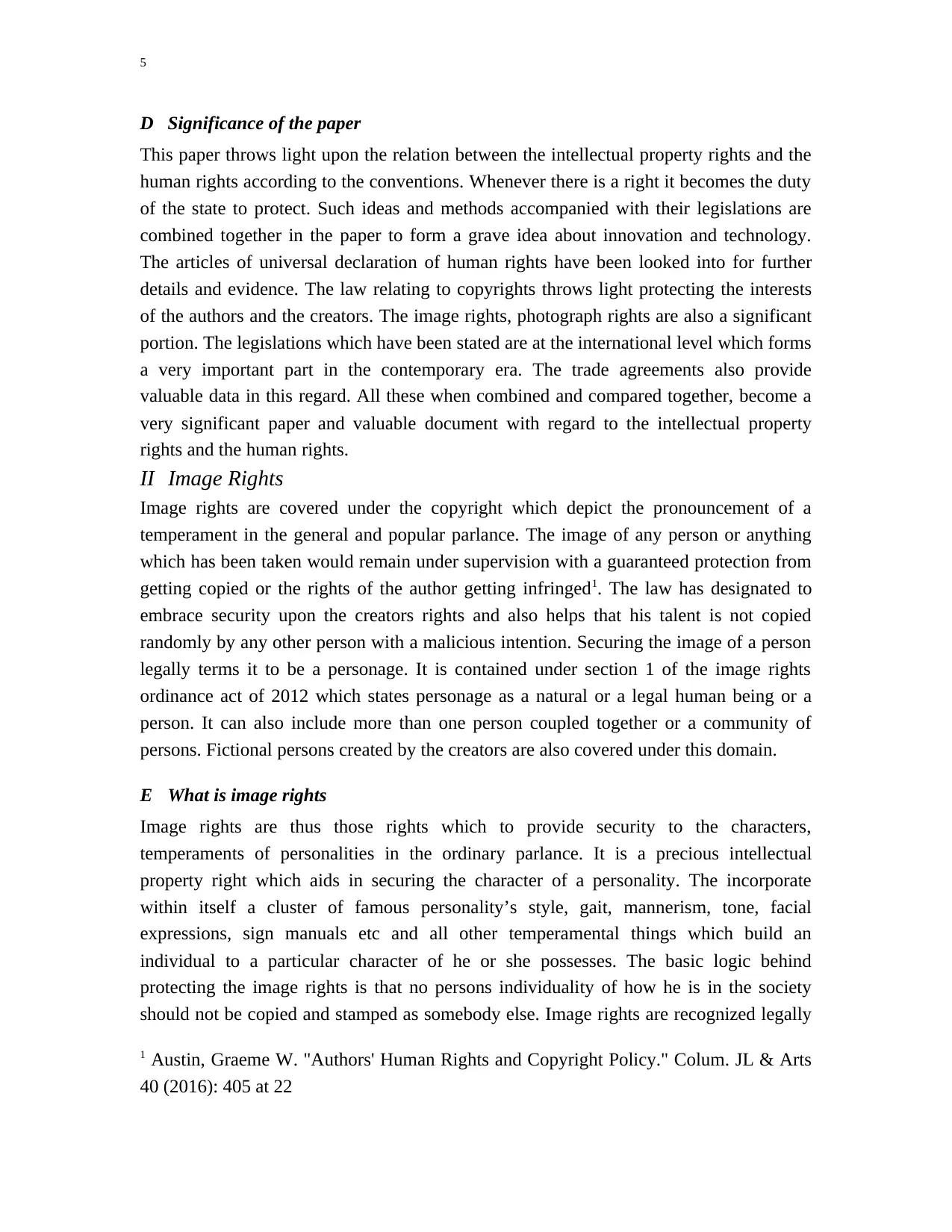
5
D Significance of the paper
This paper throws light upon the relation between the intellectual property rights and the
human rights according to the conventions. Whenever there is a right it becomes the duty
of the state to protect. Such ideas and methods accompanied with their legislations are
combined together in the paper to form a grave idea about innovation and technology.
The articles of universal declaration of human rights have been looked into for further
details and evidence. The law relating to copyrights throws light protecting the interests
of the authors and the creators. The image rights, photograph rights are also a significant
portion. The legislations which have been stated are at the international level which forms
a very important part in the contemporary era. The trade agreements also provide
valuable data in this regard. All these when combined and compared together, become a
very significant paper and valuable document with regard to the intellectual property
rights and the human rights.
II Image Rights
Image rights are covered under the copyright which depict the pronouncement of a
temperament in the general and popular parlance. The image of any person or anything
which has been taken would remain under supervision with a guaranteed protection from
getting copied or the rights of the author getting infringed1. The law has designated to
embrace security upon the creators rights and also helps that his talent is not copied
randomly by any other person with a malicious intention. Securing the image of a person
legally terms it to be a personage. It is contained under section 1 of the image rights
ordinance act of 2012 which states personage as a natural or a legal human being or a
person. It can also include more than one person coupled together or a community of
persons. Fictional persons created by the creators are also covered under this domain.
E What is image rights
Image rights are thus those rights which to provide security to the characters,
temperaments of personalities in the ordinary parlance. It is a precious intellectual
property right which aids in securing the character of a personality. The incorporate
within itself a cluster of famous personality’s style, gait, mannerism, tone, facial
expressions, sign manuals etc and all other temperamental things which build an
individual to a particular character of he or she possesses. The basic logic behind
protecting the image rights is that no persons individuality of how he is in the society
should not be copied and stamped as somebody else. Image rights are recognized legally
1 Austin, Graeme W. "Authors' Human Rights and Copyright Policy." Colum. JL & Arts
40 (2016): 405 at 22
D Significance of the paper
This paper throws light upon the relation between the intellectual property rights and the
human rights according to the conventions. Whenever there is a right it becomes the duty
of the state to protect. Such ideas and methods accompanied with their legislations are
combined together in the paper to form a grave idea about innovation and technology.
The articles of universal declaration of human rights have been looked into for further
details and evidence. The law relating to copyrights throws light protecting the interests
of the authors and the creators. The image rights, photograph rights are also a significant
portion. The legislations which have been stated are at the international level which forms
a very important part in the contemporary era. The trade agreements also provide
valuable data in this regard. All these when combined and compared together, become a
very significant paper and valuable document with regard to the intellectual property
rights and the human rights.
II Image Rights
Image rights are covered under the copyright which depict the pronouncement of a
temperament in the general and popular parlance. The image of any person or anything
which has been taken would remain under supervision with a guaranteed protection from
getting copied or the rights of the author getting infringed1. The law has designated to
embrace security upon the creators rights and also helps that his talent is not copied
randomly by any other person with a malicious intention. Securing the image of a person
legally terms it to be a personage. It is contained under section 1 of the image rights
ordinance act of 2012 which states personage as a natural or a legal human being or a
person. It can also include more than one person coupled together or a community of
persons. Fictional persons created by the creators are also covered under this domain.
E What is image rights
Image rights are thus those rights which to provide security to the characters,
temperaments of personalities in the ordinary parlance. It is a precious intellectual
property right which aids in securing the character of a personality. The incorporate
within itself a cluster of famous personality’s style, gait, mannerism, tone, facial
expressions, sign manuals etc and all other temperamental things which build an
individual to a particular character of he or she possesses. The basic logic behind
protecting the image rights is that no persons individuality of how he is in the society
should not be copied and stamped as somebody else. Image rights are recognized legally
1 Austin, Graeme W. "Authors' Human Rights and Copyright Policy." Colum. JL & Arts
40 (2016): 405 at 22
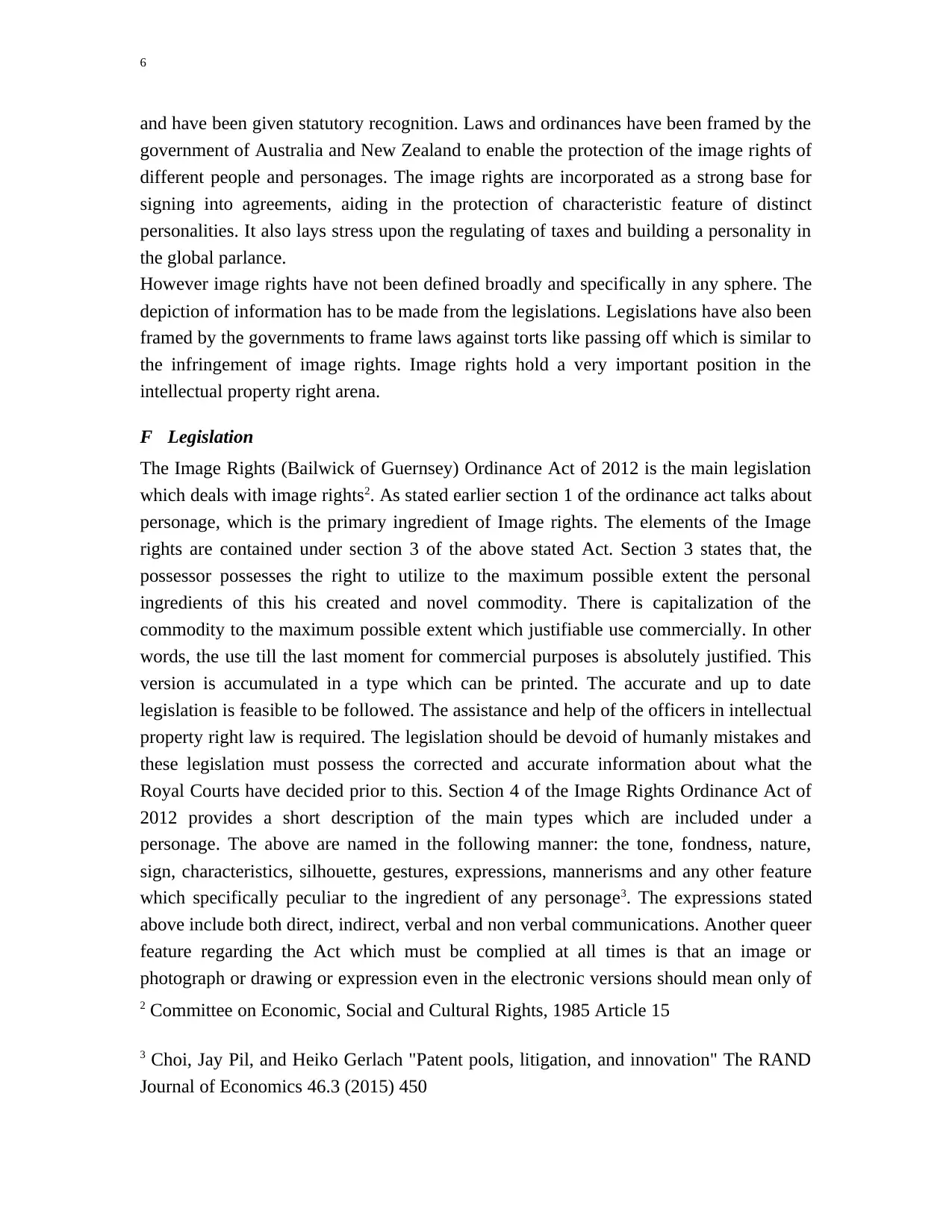
6
and have been given statutory recognition. Laws and ordinances have been framed by the
government of Australia and New Zealand to enable the protection of the image rights of
different people and personages. The image rights are incorporated as a strong base for
signing into agreements, aiding in the protection of characteristic feature of distinct
personalities. It also lays stress upon the regulating of taxes and building a personality in
the global parlance.
However image rights have not been defined broadly and specifically in any sphere. The
depiction of information has to be made from the legislations. Legislations have also been
framed by the governments to frame laws against torts like passing off which is similar to
the infringement of image rights. Image rights hold a very important position in the
intellectual property right arena.
F Legislation
The Image Rights (Bailwick of Guernsey) Ordinance Act of 2012 is the main legislation
which deals with image rights2. As stated earlier section 1 of the ordinance act talks about
personage, which is the primary ingredient of Image rights. The elements of the Image
rights are contained under section 3 of the above stated Act. Section 3 states that, the
possessor possesses the right to utilize to the maximum possible extent the personal
ingredients of this his created and novel commodity. There is capitalization of the
commodity to the maximum possible extent which justifiable use commercially. In other
words, the use till the last moment for commercial purposes is absolutely justified. This
version is accumulated in a type which can be printed. The accurate and up to date
legislation is feasible to be followed. The assistance and help of the officers in intellectual
property right law is required. The legislation should be devoid of humanly mistakes and
these legislation must possess the corrected and accurate information about what the
Royal Courts have decided prior to this. Section 4 of the Image Rights Ordinance Act of
2012 provides a short description of the main types which are included under a
personage. The above are named in the following manner: the tone, fondness, nature,
sign, characteristics, silhouette, gestures, expressions, mannerisms and any other feature
which specifically peculiar to the ingredient of any personage3. The expressions stated
above include both direct, indirect, verbal and non verbal communications. Another queer
feature regarding the Act which must be complied at all times is that an image or
photograph or drawing or expression even in the electronic versions should mean only of
2 Committee on Economic, Social and Cultural Rights, 1985 Article 15
3 Choi, Jay Pil, and Heiko Gerlach "Patent pools, litigation, and innovation" The RAND
Journal of Economics 46.3 (2015) 450
and have been given statutory recognition. Laws and ordinances have been framed by the
government of Australia and New Zealand to enable the protection of the image rights of
different people and personages. The image rights are incorporated as a strong base for
signing into agreements, aiding in the protection of characteristic feature of distinct
personalities. It also lays stress upon the regulating of taxes and building a personality in
the global parlance.
However image rights have not been defined broadly and specifically in any sphere. The
depiction of information has to be made from the legislations. Legislations have also been
framed by the governments to frame laws against torts like passing off which is similar to
the infringement of image rights. Image rights hold a very important position in the
intellectual property right arena.
F Legislation
The Image Rights (Bailwick of Guernsey) Ordinance Act of 2012 is the main legislation
which deals with image rights2. As stated earlier section 1 of the ordinance act talks about
personage, which is the primary ingredient of Image rights. The elements of the Image
rights are contained under section 3 of the above stated Act. Section 3 states that, the
possessor possesses the right to utilize to the maximum possible extent the personal
ingredients of this his created and novel commodity. There is capitalization of the
commodity to the maximum possible extent which justifiable use commercially. In other
words, the use till the last moment for commercial purposes is absolutely justified. This
version is accumulated in a type which can be printed. The accurate and up to date
legislation is feasible to be followed. The assistance and help of the officers in intellectual
property right law is required. The legislation should be devoid of humanly mistakes and
these legislation must possess the corrected and accurate information about what the
Royal Courts have decided prior to this. Section 4 of the Image Rights Ordinance Act of
2012 provides a short description of the main types which are included under a
personage. The above are named in the following manner: the tone, fondness, nature,
sign, characteristics, silhouette, gestures, expressions, mannerisms and any other feature
which specifically peculiar to the ingredient of any personage3. The expressions stated
above include both direct, indirect, verbal and non verbal communications. Another queer
feature regarding the Act which must be complied at all times is that an image or
photograph or drawing or expression even in the electronic versions should mean only of
2 Committee on Economic, Social and Cultural Rights, 1985 Article 15
3 Choi, Jay Pil, and Heiko Gerlach "Patent pools, litigation, and innovation" The RAND
Journal of Economics 46.3 (2015) 450
⊘ This is a preview!⊘
Do you want full access?
Subscribe today to unlock all pages.

Trusted by 1+ million students worldwide
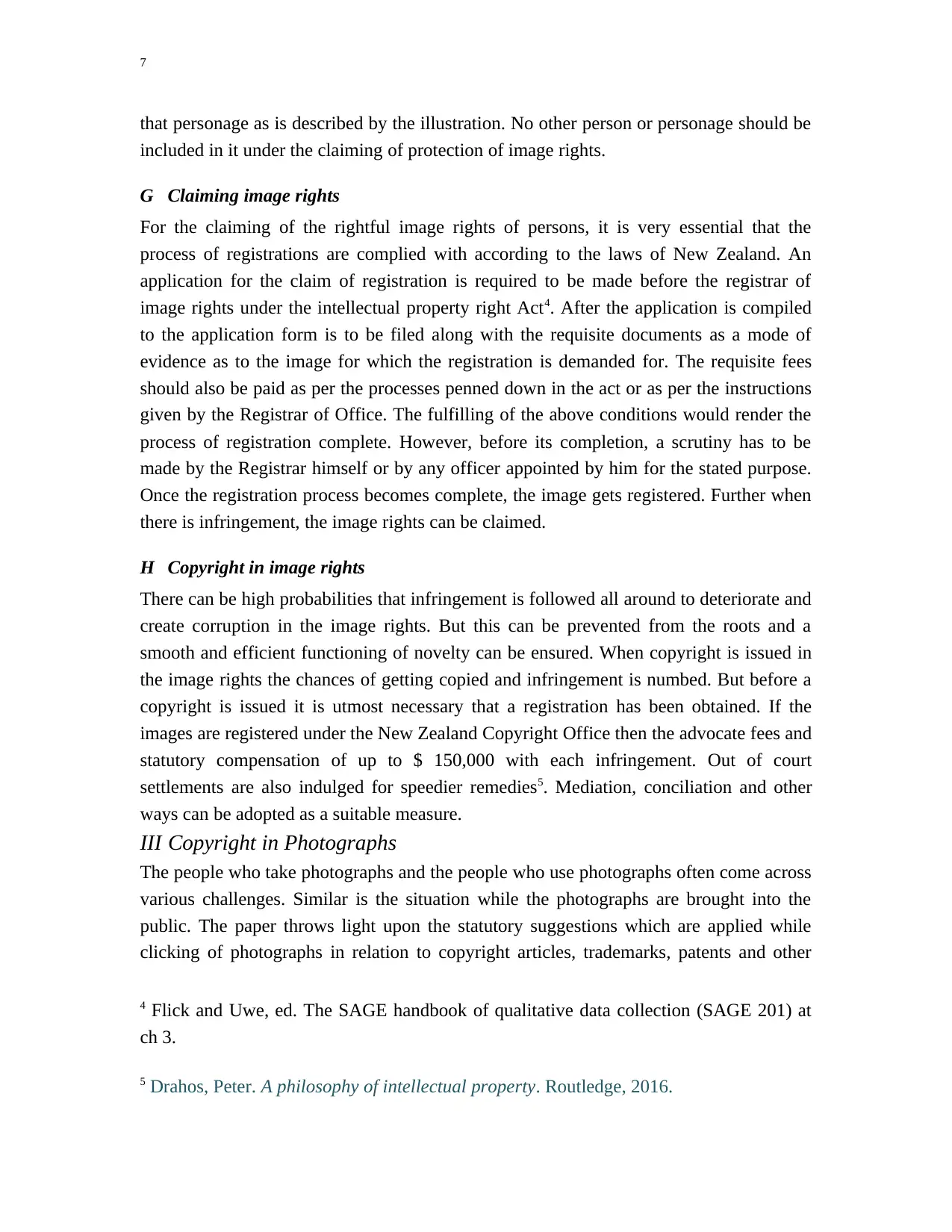
7
that personage as is described by the illustration. No other person or personage should be
included in it under the claiming of protection of image rights.
G Claiming image rights
For the claiming of the rightful image rights of persons, it is very essential that the
process of registrations are complied with according to the laws of New Zealand. An
application for the claim of registration is required to be made before the registrar of
image rights under the intellectual property right Act4. After the application is compiled
to the application form is to be filed along with the requisite documents as a mode of
evidence as to the image for which the registration is demanded for. The requisite fees
should also be paid as per the processes penned down in the act or as per the instructions
given by the Registrar of Office. The fulfilling of the above conditions would render the
process of registration complete. However, before its completion, a scrutiny has to be
made by the Registrar himself or by any officer appointed by him for the stated purpose.
Once the registration process becomes complete, the image gets registered. Further when
there is infringement, the image rights can be claimed.
H Copyright in image rights
There can be high probabilities that infringement is followed all around to deteriorate and
create corruption in the image rights. But this can be prevented from the roots and a
smooth and efficient functioning of novelty can be ensured. When copyright is issued in
the image rights the chances of getting copied and infringement is numbed. But before a
copyright is issued it is utmost necessary that a registration has been obtained. If the
images are registered under the New Zealand Copyright Office then the advocate fees and
statutory compensation of up to $ 150,000 with each infringement. Out of court
settlements are also indulged for speedier remedies5. Mediation, conciliation and other
ways can be adopted as a suitable measure.
III Copyright in Photographs
The people who take photographs and the people who use photographs often come across
various challenges. Similar is the situation while the photographs are brought into the
public. The paper throws light upon the statutory suggestions which are applied while
clicking of photographs in relation to copyright articles, trademarks, patents and other
4 Flick and Uwe, ed. The SAGE handbook of qualitative data collection (SAGE 201) at
ch 3.
5 Drahos, Peter. A philosophy of intellectual property. Routledge, 2016.
that personage as is described by the illustration. No other person or personage should be
included in it under the claiming of protection of image rights.
G Claiming image rights
For the claiming of the rightful image rights of persons, it is very essential that the
process of registrations are complied with according to the laws of New Zealand. An
application for the claim of registration is required to be made before the registrar of
image rights under the intellectual property right Act4. After the application is compiled
to the application form is to be filed along with the requisite documents as a mode of
evidence as to the image for which the registration is demanded for. The requisite fees
should also be paid as per the processes penned down in the act or as per the instructions
given by the Registrar of Office. The fulfilling of the above conditions would render the
process of registration complete. However, before its completion, a scrutiny has to be
made by the Registrar himself or by any officer appointed by him for the stated purpose.
Once the registration process becomes complete, the image gets registered. Further when
there is infringement, the image rights can be claimed.
H Copyright in image rights
There can be high probabilities that infringement is followed all around to deteriorate and
create corruption in the image rights. But this can be prevented from the roots and a
smooth and efficient functioning of novelty can be ensured. When copyright is issued in
the image rights the chances of getting copied and infringement is numbed. But before a
copyright is issued it is utmost necessary that a registration has been obtained. If the
images are registered under the New Zealand Copyright Office then the advocate fees and
statutory compensation of up to $ 150,000 with each infringement. Out of court
settlements are also indulged for speedier remedies5. Mediation, conciliation and other
ways can be adopted as a suitable measure.
III Copyright in Photographs
The people who take photographs and the people who use photographs often come across
various challenges. Similar is the situation while the photographs are brought into the
public. The paper throws light upon the statutory suggestions which are applied while
clicking of photographs in relation to copyright articles, trademarks, patents and other
4 Flick and Uwe, ed. The SAGE handbook of qualitative data collection (SAGE 201) at
ch 3.
5 Drahos, Peter. A philosophy of intellectual property. Routledge, 2016.
Paraphrase This Document
Need a fresh take? Get an instant paraphrase of this document with our AI Paraphraser
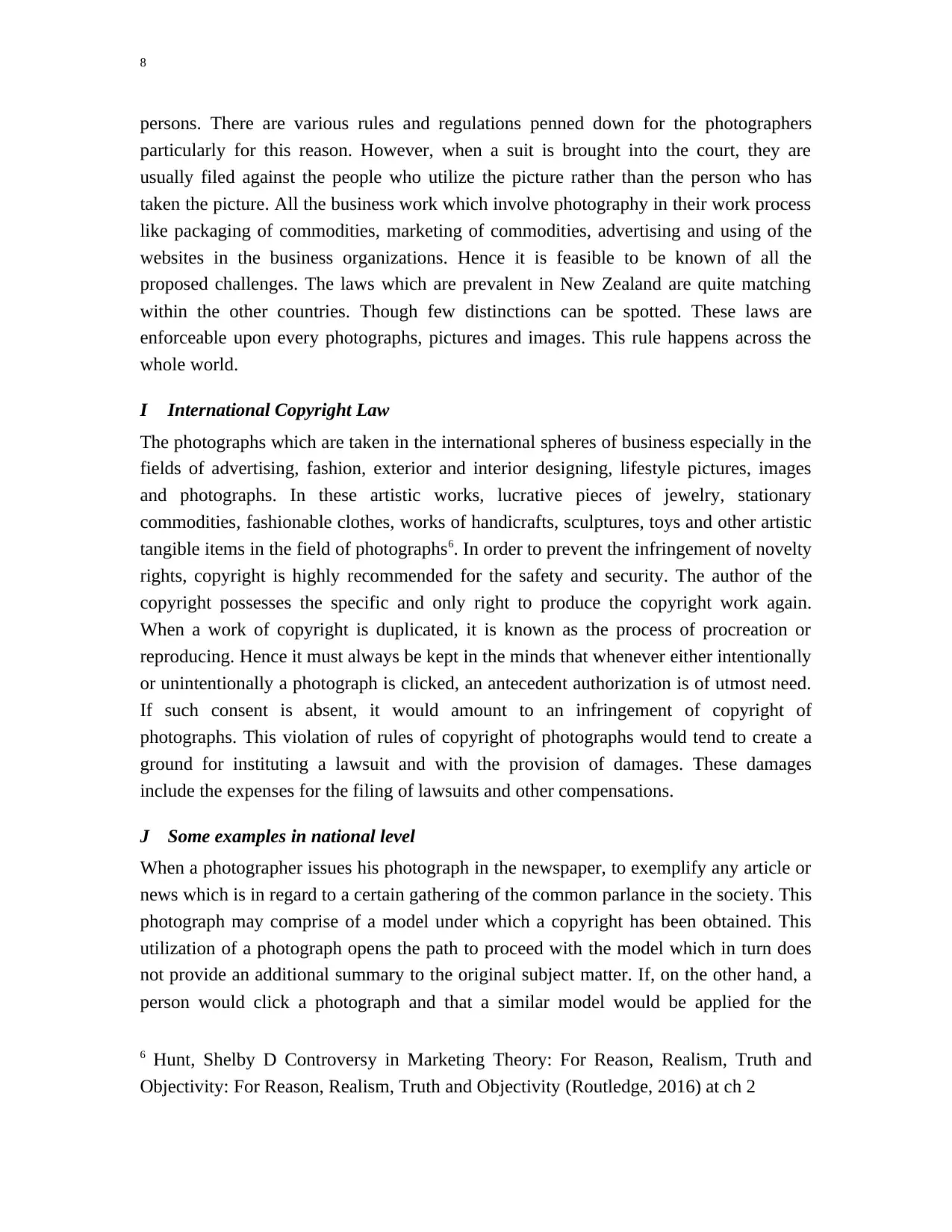
8
persons. There are various rules and regulations penned down for the photographers
particularly for this reason. However, when a suit is brought into the court, they are
usually filed against the people who utilize the picture rather than the person who has
taken the picture. All the business work which involve photography in their work process
like packaging of commodities, marketing of commodities, advertising and using of the
websites in the business organizations. Hence it is feasible to be known of all the
proposed challenges. The laws which are prevalent in New Zealand are quite matching
within the other countries. Though few distinctions can be spotted. These laws are
enforceable upon every photographs, pictures and images. This rule happens across the
whole world.
I International Copyright Law
The photographs which are taken in the international spheres of business especially in the
fields of advertising, fashion, exterior and interior designing, lifestyle pictures, images
and photographs. In these artistic works, lucrative pieces of jewelry, stationary
commodities, fashionable clothes, works of handicrafts, sculptures, toys and other artistic
tangible items in the field of photographs6. In order to prevent the infringement of novelty
rights, copyright is highly recommended for the safety and security. The author of the
copyright possesses the specific and only right to produce the copyright work again.
When a work of copyright is duplicated, it is known as the process of procreation or
reproducing. Hence it must always be kept in the minds that whenever either intentionally
or unintentionally a photograph is clicked, an antecedent authorization is of utmost need.
If such consent is absent, it would amount to an infringement of copyright of
photographs. This violation of rules of copyright of photographs would tend to create a
ground for instituting a lawsuit and with the provision of damages. These damages
include the expenses for the filing of lawsuits and other compensations.
J Some examples in national level
When a photographer issues his photograph in the newspaper, to exemplify any article or
news which is in regard to a certain gathering of the common parlance in the society. This
photograph may comprise of a model under which a copyright has been obtained. This
utilization of a photograph opens the path to proceed with the model which in turn does
not provide an additional summary to the original subject matter. If, on the other hand, a
person would click a photograph and that a similar model would be applied for the
6 Hunt, Shelby D Controversy in Marketing Theory: For Reason, Realism, Truth and
Objectivity: For Reason, Realism, Truth and Objectivity (Routledge, 2016) at ch 2
persons. There are various rules and regulations penned down for the photographers
particularly for this reason. However, when a suit is brought into the court, they are
usually filed against the people who utilize the picture rather than the person who has
taken the picture. All the business work which involve photography in their work process
like packaging of commodities, marketing of commodities, advertising and using of the
websites in the business organizations. Hence it is feasible to be known of all the
proposed challenges. The laws which are prevalent in New Zealand are quite matching
within the other countries. Though few distinctions can be spotted. These laws are
enforceable upon every photographs, pictures and images. This rule happens across the
whole world.
I International Copyright Law
The photographs which are taken in the international spheres of business especially in the
fields of advertising, fashion, exterior and interior designing, lifestyle pictures, images
and photographs. In these artistic works, lucrative pieces of jewelry, stationary
commodities, fashionable clothes, works of handicrafts, sculptures, toys and other artistic
tangible items in the field of photographs6. In order to prevent the infringement of novelty
rights, copyright is highly recommended for the safety and security. The author of the
copyright possesses the specific and only right to produce the copyright work again.
When a work of copyright is duplicated, it is known as the process of procreation or
reproducing. Hence it must always be kept in the minds that whenever either intentionally
or unintentionally a photograph is clicked, an antecedent authorization is of utmost need.
If such consent is absent, it would amount to an infringement of copyright of
photographs. This violation of rules of copyright of photographs would tend to create a
ground for instituting a lawsuit and with the provision of damages. These damages
include the expenses for the filing of lawsuits and other compensations.
J Some examples in national level
When a photographer issues his photograph in the newspaper, to exemplify any article or
news which is in regard to a certain gathering of the common parlance in the society. This
photograph may comprise of a model under which a copyright has been obtained. This
utilization of a photograph opens the path to proceed with the model which in turn does
not provide an additional summary to the original subject matter. If, on the other hand, a
person would click a photograph and that a similar model would be applied for the
6 Hunt, Shelby D Controversy in Marketing Theory: For Reason, Realism, Truth and
Objectivity: For Reason, Realism, Truth and Objectivity (Routledge, 2016) at ch 2
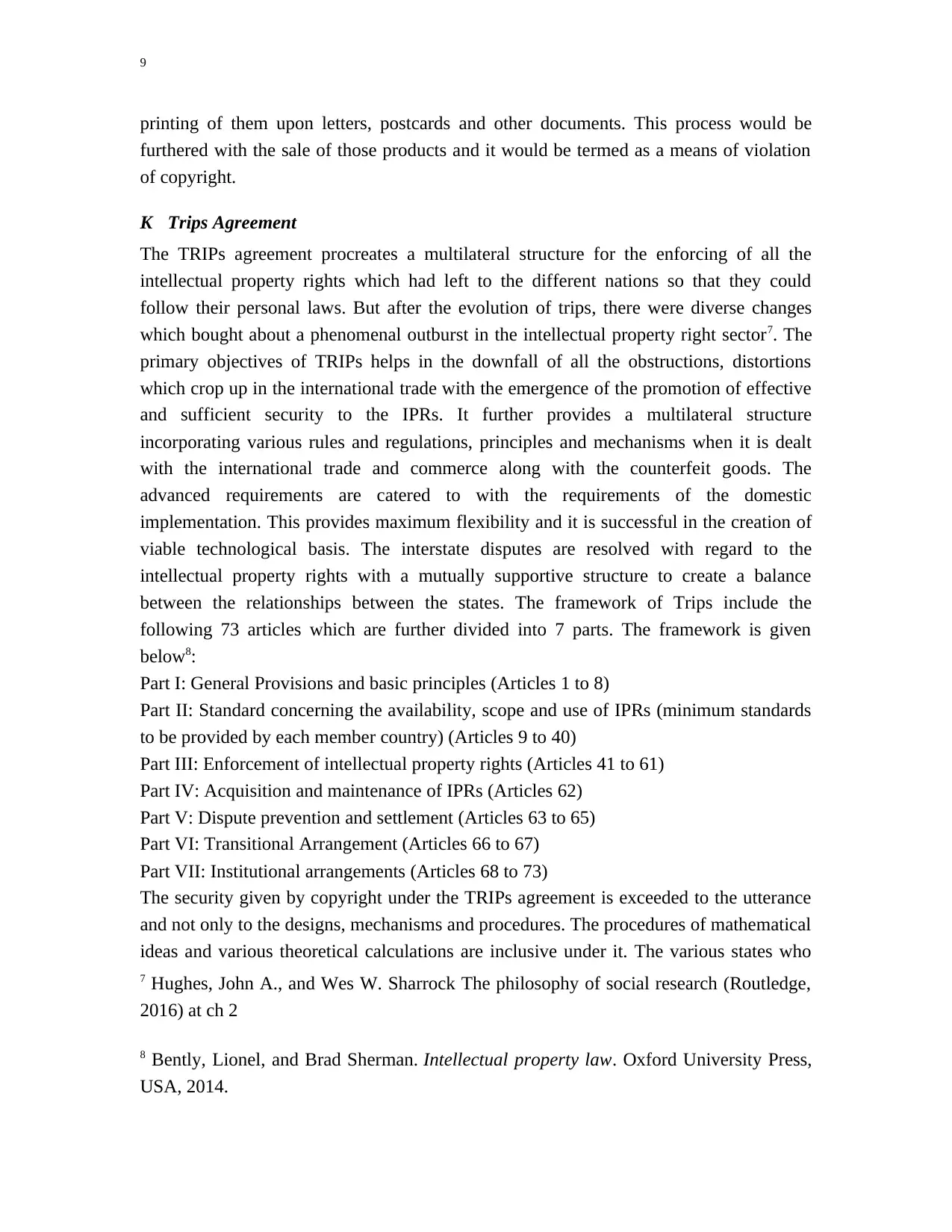
9
printing of them upon letters, postcards and other documents. This process would be
furthered with the sale of those products and it would be termed as a means of violation
of copyright.
K Trips Agreement
The TRIPs agreement procreates a multilateral structure for the enforcing of all the
intellectual property rights which had left to the different nations so that they could
follow their personal laws. But after the evolution of trips, there were diverse changes
which bought about a phenomenal outburst in the intellectual property right sector7. The
primary objectives of TRIPs helps in the downfall of all the obstructions, distortions
which crop up in the international trade with the emergence of the promotion of effective
and sufficient security to the IPRs. It further provides a multilateral structure
incorporating various rules and regulations, principles and mechanisms when it is dealt
with the international trade and commerce along with the counterfeit goods. The
advanced requirements are catered to with the requirements of the domestic
implementation. This provides maximum flexibility and it is successful in the creation of
viable technological basis. The interstate disputes are resolved with regard to the
intellectual property rights with a mutually supportive structure to create a balance
between the relationships between the states. The framework of Trips include the
following 73 articles which are further divided into 7 parts. The framework is given
below8:
Part I: General Provisions and basic principles (Articles 1 to 8)
Part II: Standard concerning the availability, scope and use of IPRs (minimum standards
to be provided by each member country) (Articles 9 to 40)
Part III: Enforcement of intellectual property rights (Articles 41 to 61)
Part IV: Acquisition and maintenance of IPRs (Articles 62)
Part V: Dispute prevention and settlement (Articles 63 to 65)
Part VI: Transitional Arrangement (Articles 66 to 67)
Part VII: Institutional arrangements (Articles 68 to 73)
The security given by copyright under the TRIPs agreement is exceeded to the utterance
and not only to the designs, mechanisms and procedures. The procedures of mathematical
ideas and various theoretical calculations are inclusive under it. The various states who
7 Hughes, John A., and Wes W. Sharrock The philosophy of social research (Routledge,
2016) at ch 2
8 Bently, Lionel, and Brad Sherman. Intellectual property law. Oxford University Press,
USA, 2014.
printing of them upon letters, postcards and other documents. This process would be
furthered with the sale of those products and it would be termed as a means of violation
of copyright.
K Trips Agreement
The TRIPs agreement procreates a multilateral structure for the enforcing of all the
intellectual property rights which had left to the different nations so that they could
follow their personal laws. But after the evolution of trips, there were diverse changes
which bought about a phenomenal outburst in the intellectual property right sector7. The
primary objectives of TRIPs helps in the downfall of all the obstructions, distortions
which crop up in the international trade with the emergence of the promotion of effective
and sufficient security to the IPRs. It further provides a multilateral structure
incorporating various rules and regulations, principles and mechanisms when it is dealt
with the international trade and commerce along with the counterfeit goods. The
advanced requirements are catered to with the requirements of the domestic
implementation. This provides maximum flexibility and it is successful in the creation of
viable technological basis. The interstate disputes are resolved with regard to the
intellectual property rights with a mutually supportive structure to create a balance
between the relationships between the states. The framework of Trips include the
following 73 articles which are further divided into 7 parts. The framework is given
below8:
Part I: General Provisions and basic principles (Articles 1 to 8)
Part II: Standard concerning the availability, scope and use of IPRs (minimum standards
to be provided by each member country) (Articles 9 to 40)
Part III: Enforcement of intellectual property rights (Articles 41 to 61)
Part IV: Acquisition and maintenance of IPRs (Articles 62)
Part V: Dispute prevention and settlement (Articles 63 to 65)
Part VI: Transitional Arrangement (Articles 66 to 67)
Part VII: Institutional arrangements (Articles 68 to 73)
The security given by copyright under the TRIPs agreement is exceeded to the utterance
and not only to the designs, mechanisms and procedures. The procedures of mathematical
ideas and various theoretical calculations are inclusive under it. The various states who
7 Hughes, John A., and Wes W. Sharrock The philosophy of social research (Routledge,
2016) at ch 2
8 Bently, Lionel, and Brad Sherman. Intellectual property law. Oxford University Press,
USA, 2014.
⊘ This is a preview!⊘
Do you want full access?
Subscribe today to unlock all pages.

Trusted by 1+ million students worldwide
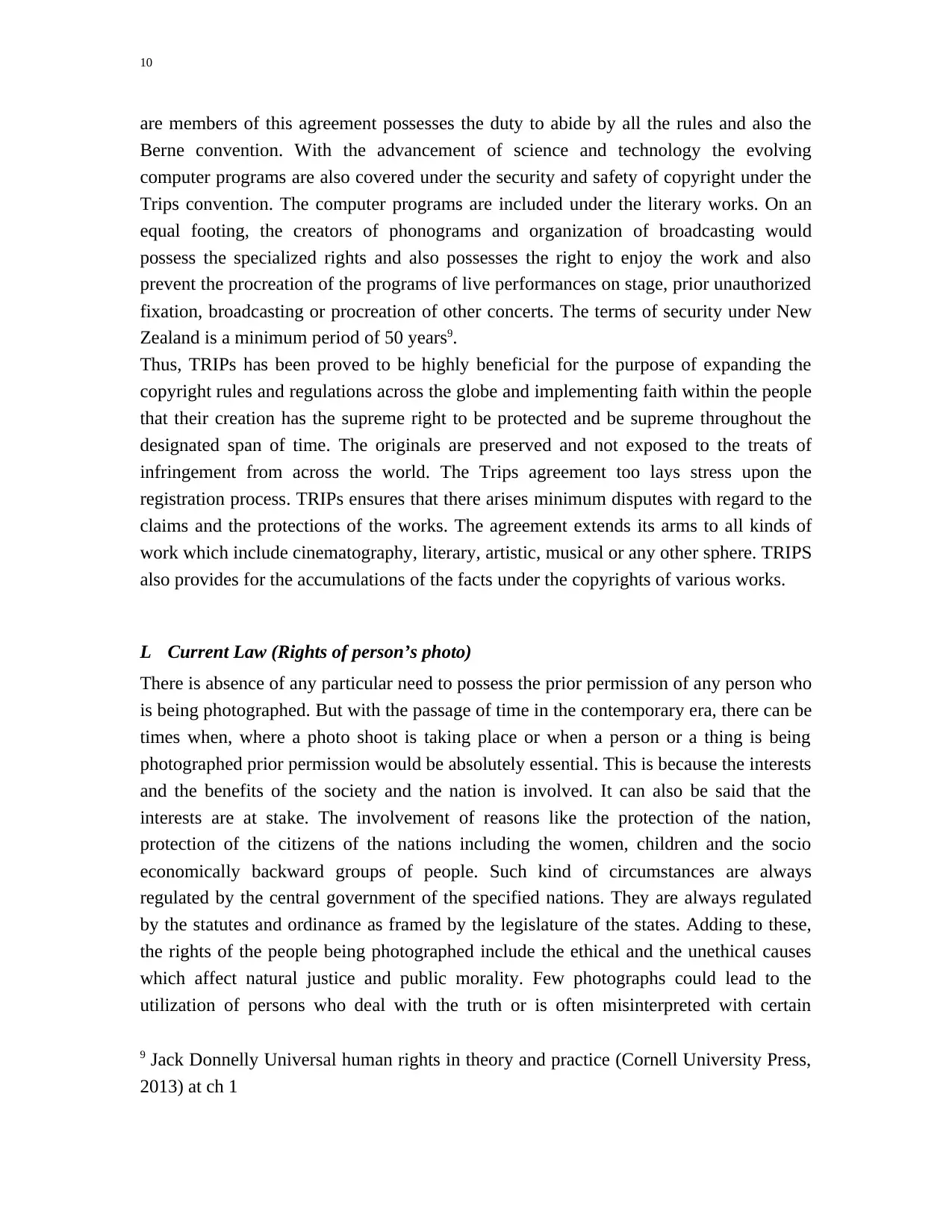
10
are members of this agreement possesses the duty to abide by all the rules and also the
Berne convention. With the advancement of science and technology the evolving
computer programs are also covered under the security and safety of copyright under the
Trips convention. The computer programs are included under the literary works. On an
equal footing, the creators of phonograms and organization of broadcasting would
possess the specialized rights and also possesses the right to enjoy the work and also
prevent the procreation of the programs of live performances on stage, prior unauthorized
fixation, broadcasting or procreation of other concerts. The terms of security under New
Zealand is a minimum period of 50 years9.
Thus, TRIPs has been proved to be highly beneficial for the purpose of expanding the
copyright rules and regulations across the globe and implementing faith within the people
that their creation has the supreme right to be protected and be supreme throughout the
designated span of time. The originals are preserved and not exposed to the treats of
infringement from across the world. The Trips agreement too lays stress upon the
registration process. TRIPs ensures that there arises minimum disputes with regard to the
claims and the protections of the works. The agreement extends its arms to all kinds of
work which include cinematography, literary, artistic, musical or any other sphere. TRIPS
also provides for the accumulations of the facts under the copyrights of various works.
L Current Law (Rights of person’s photo)
There is absence of any particular need to possess the prior permission of any person who
is being photographed. But with the passage of time in the contemporary era, there can be
times when, where a photo shoot is taking place or when a person or a thing is being
photographed prior permission would be absolutely essential. This is because the interests
and the benefits of the society and the nation is involved. It can also be said that the
interests are at stake. The involvement of reasons like the protection of the nation,
protection of the citizens of the nations including the women, children and the socio
economically backward groups of people. Such kind of circumstances are always
regulated by the central government of the specified nations. They are always regulated
by the statutes and ordinance as framed by the legislature of the states. Adding to these,
the rights of the people being photographed include the ethical and the unethical causes
which affect natural justice and public morality. Few photographs could lead to the
utilization of persons who deal with the truth or is often misinterpreted with certain
9 Jack Donnelly Universal human rights in theory and practice (Cornell University Press,
2013) at ch 1
are members of this agreement possesses the duty to abide by all the rules and also the
Berne convention. With the advancement of science and technology the evolving
computer programs are also covered under the security and safety of copyright under the
Trips convention. The computer programs are included under the literary works. On an
equal footing, the creators of phonograms and organization of broadcasting would
possess the specialized rights and also possesses the right to enjoy the work and also
prevent the procreation of the programs of live performances on stage, prior unauthorized
fixation, broadcasting or procreation of other concerts. The terms of security under New
Zealand is a minimum period of 50 years9.
Thus, TRIPs has been proved to be highly beneficial for the purpose of expanding the
copyright rules and regulations across the globe and implementing faith within the people
that their creation has the supreme right to be protected and be supreme throughout the
designated span of time. The originals are preserved and not exposed to the treats of
infringement from across the world. The Trips agreement too lays stress upon the
registration process. TRIPs ensures that there arises minimum disputes with regard to the
claims and the protections of the works. The agreement extends its arms to all kinds of
work which include cinematography, literary, artistic, musical or any other sphere. TRIPS
also provides for the accumulations of the facts under the copyrights of various works.
L Current Law (Rights of person’s photo)
There is absence of any particular need to possess the prior permission of any person who
is being photographed. But with the passage of time in the contemporary era, there can be
times when, where a photo shoot is taking place or when a person or a thing is being
photographed prior permission would be absolutely essential. This is because the interests
and the benefits of the society and the nation is involved. It can also be said that the
interests are at stake. The involvement of reasons like the protection of the nation,
protection of the citizens of the nations including the women, children and the socio
economically backward groups of people. Such kind of circumstances are always
regulated by the central government of the specified nations. They are always regulated
by the statutes and ordinance as framed by the legislature of the states. Adding to these,
the rights of the people being photographed include the ethical and the unethical causes
which affect natural justice and public morality. Few photographs could lead to the
utilization of persons who deal with the truth or is often misinterpreted with certain
9 Jack Donnelly Universal human rights in theory and practice (Cornell University Press,
2013) at ch 1
Paraphrase This Document
Need a fresh take? Get an instant paraphrase of this document with our AI Paraphraser
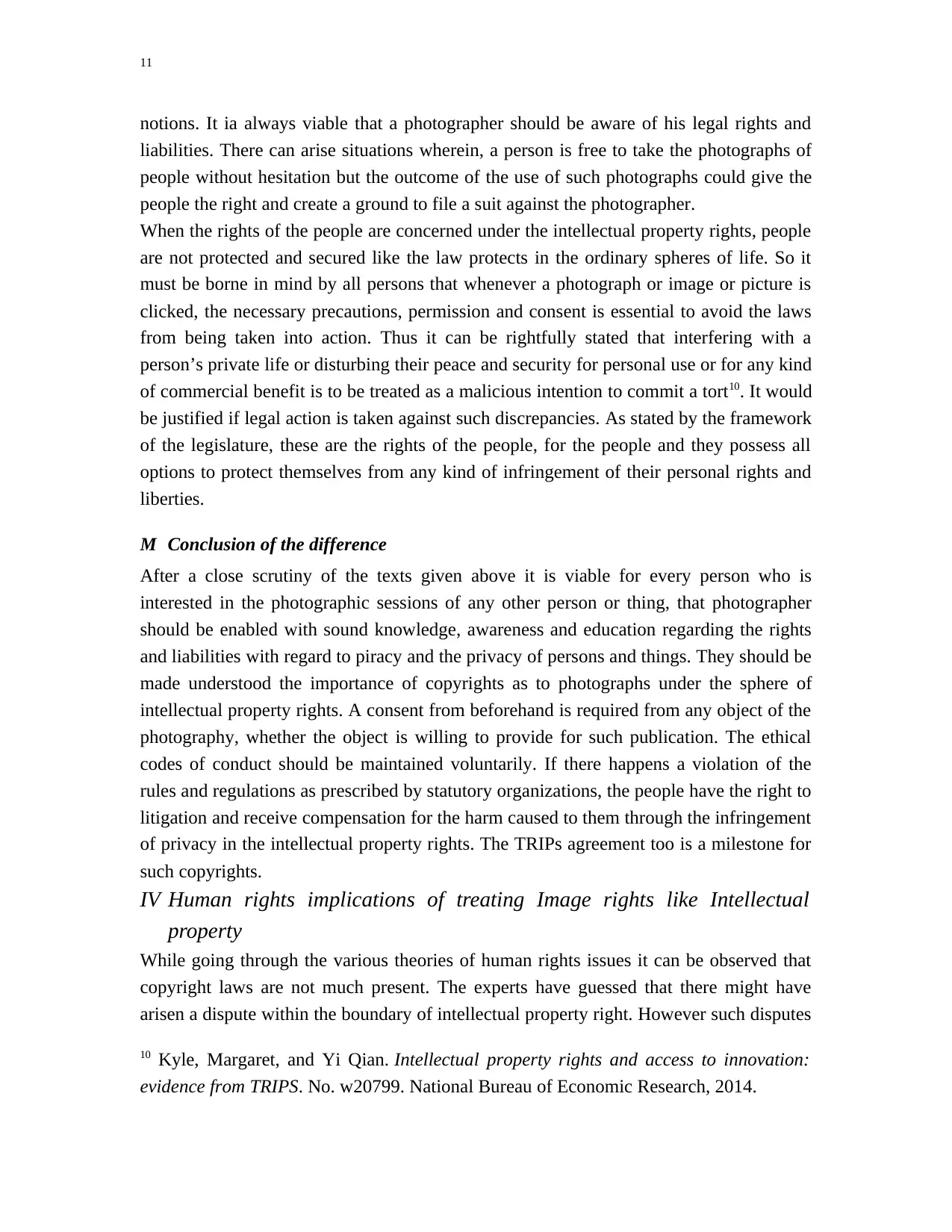
11
notions. It ia always viable that a photographer should be aware of his legal rights and
liabilities. There can arise situations wherein, a person is free to take the photographs of
people without hesitation but the outcome of the use of such photographs could give the
people the right and create a ground to file a suit against the photographer.
When the rights of the people are concerned under the intellectual property rights, people
are not protected and secured like the law protects in the ordinary spheres of life. So it
must be borne in mind by all persons that whenever a photograph or image or picture is
clicked, the necessary precautions, permission and consent is essential to avoid the laws
from being taken into action. Thus it can be rightfully stated that interfering with a
person’s private life or disturbing their peace and security for personal use or for any kind
of commercial benefit is to be treated as a malicious intention to commit a tort10. It would
be justified if legal action is taken against such discrepancies. As stated by the framework
of the legislature, these are the rights of the people, for the people and they possess all
options to protect themselves from any kind of infringement of their personal rights and
liberties.
M Conclusion of the difference
After a close scrutiny of the texts given above it is viable for every person who is
interested in the photographic sessions of any other person or thing, that photographer
should be enabled with sound knowledge, awareness and education regarding the rights
and liabilities with regard to piracy and the privacy of persons and things. They should be
made understood the importance of copyrights as to photographs under the sphere of
intellectual property rights. A consent from beforehand is required from any object of the
photography, whether the object is willing to provide for such publication. The ethical
codes of conduct should be maintained voluntarily. If there happens a violation of the
rules and regulations as prescribed by statutory organizations, the people have the right to
litigation and receive compensation for the harm caused to them through the infringement
of privacy in the intellectual property rights. The TRIPs agreement too is a milestone for
such copyrights.
IV Human rights implications of treating Image rights like Intellectual
property
While going through the various theories of human rights issues it can be observed that
copyright laws are not much present. The experts have guessed that there might have
arisen a dispute within the boundary of intellectual property right. However such disputes
10 Kyle, Margaret, and Yi Qian. Intellectual property rights and access to innovation:
evidence from TRIPS. No. w20799. National Bureau of Economic Research, 2014.
notions. It ia always viable that a photographer should be aware of his legal rights and
liabilities. There can arise situations wherein, a person is free to take the photographs of
people without hesitation but the outcome of the use of such photographs could give the
people the right and create a ground to file a suit against the photographer.
When the rights of the people are concerned under the intellectual property rights, people
are not protected and secured like the law protects in the ordinary spheres of life. So it
must be borne in mind by all persons that whenever a photograph or image or picture is
clicked, the necessary precautions, permission and consent is essential to avoid the laws
from being taken into action. Thus it can be rightfully stated that interfering with a
person’s private life or disturbing their peace and security for personal use or for any kind
of commercial benefit is to be treated as a malicious intention to commit a tort10. It would
be justified if legal action is taken against such discrepancies. As stated by the framework
of the legislature, these are the rights of the people, for the people and they possess all
options to protect themselves from any kind of infringement of their personal rights and
liberties.
M Conclusion of the difference
After a close scrutiny of the texts given above it is viable for every person who is
interested in the photographic sessions of any other person or thing, that photographer
should be enabled with sound knowledge, awareness and education regarding the rights
and liabilities with regard to piracy and the privacy of persons and things. They should be
made understood the importance of copyrights as to photographs under the sphere of
intellectual property rights. A consent from beforehand is required from any object of the
photography, whether the object is willing to provide for such publication. The ethical
codes of conduct should be maintained voluntarily. If there happens a violation of the
rules and regulations as prescribed by statutory organizations, the people have the right to
litigation and receive compensation for the harm caused to them through the infringement
of privacy in the intellectual property rights. The TRIPs agreement too is a milestone for
such copyrights.
IV Human rights implications of treating Image rights like Intellectual
property
While going through the various theories of human rights issues it can be observed that
copyright laws are not much present. The experts have guessed that there might have
arisen a dispute within the boundary of intellectual property right. However such disputes
10 Kyle, Margaret, and Yi Qian. Intellectual property rights and access to innovation:
evidence from TRIPS. No. w20799. National Bureau of Economic Research, 2014.
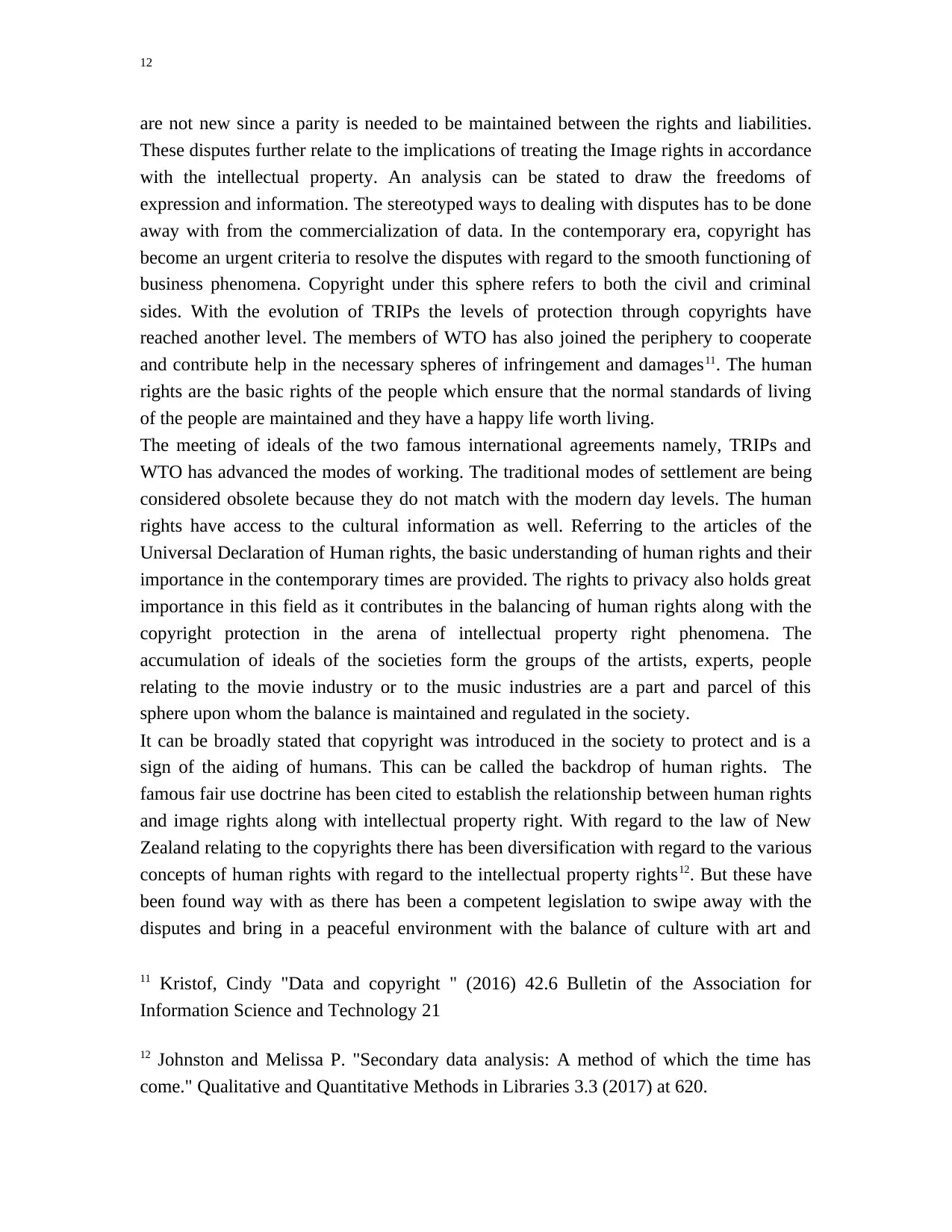
12
are not new since a parity is needed to be maintained between the rights and liabilities.
These disputes further relate to the implications of treating the Image rights in accordance
with the intellectual property. An analysis can be stated to draw the freedoms of
expression and information. The stereotyped ways to dealing with disputes has to be done
away with from the commercialization of data. In the contemporary era, copyright has
become an urgent criteria to resolve the disputes with regard to the smooth functioning of
business phenomena. Copyright under this sphere refers to both the civil and criminal
sides. With the evolution of TRIPs the levels of protection through copyrights have
reached another level. The members of WTO has also joined the periphery to cooperate
and contribute help in the necessary spheres of infringement and damages11. The human
rights are the basic rights of the people which ensure that the normal standards of living
of the people are maintained and they have a happy life worth living.
The meeting of ideals of the two famous international agreements namely, TRIPs and
WTO has advanced the modes of working. The traditional modes of settlement are being
considered obsolete because they do not match with the modern day levels. The human
rights have access to the cultural information as well. Referring to the articles of the
Universal Declaration of Human rights, the basic understanding of human rights and their
importance in the contemporary times are provided. The rights to privacy also holds great
importance in this field as it contributes in the balancing of human rights along with the
copyright protection in the arena of intellectual property right phenomena. The
accumulation of ideals of the societies form the groups of the artists, experts, people
relating to the movie industry or to the music industries are a part and parcel of this
sphere upon whom the balance is maintained and regulated in the society.
It can be broadly stated that copyright was introduced in the society to protect and is a
sign of the aiding of humans. This can be called the backdrop of human rights. The
famous fair use doctrine has been cited to establish the relationship between human rights
and image rights along with intellectual property right. With regard to the law of New
Zealand relating to the copyrights there has been diversification with regard to the various
concepts of human rights with regard to the intellectual property rights12. But these have
been found way with as there has been a competent legislation to swipe away with the
disputes and bring in a peaceful environment with the balance of culture with art and
11 Kristof, Cindy "Data and copyright " (2016) 42.6 Bulletin of the Association for
Information Science and Technology 21
12 Johnston and Melissa P. "Secondary data analysis: A method of which the time has
come." Qualitative and Quantitative Methods in Libraries 3.3 (2017) at 620.
are not new since a parity is needed to be maintained between the rights and liabilities.
These disputes further relate to the implications of treating the Image rights in accordance
with the intellectual property. An analysis can be stated to draw the freedoms of
expression and information. The stereotyped ways to dealing with disputes has to be done
away with from the commercialization of data. In the contemporary era, copyright has
become an urgent criteria to resolve the disputes with regard to the smooth functioning of
business phenomena. Copyright under this sphere refers to both the civil and criminal
sides. With the evolution of TRIPs the levels of protection through copyrights have
reached another level. The members of WTO has also joined the periphery to cooperate
and contribute help in the necessary spheres of infringement and damages11. The human
rights are the basic rights of the people which ensure that the normal standards of living
of the people are maintained and they have a happy life worth living.
The meeting of ideals of the two famous international agreements namely, TRIPs and
WTO has advanced the modes of working. The traditional modes of settlement are being
considered obsolete because they do not match with the modern day levels. The human
rights have access to the cultural information as well. Referring to the articles of the
Universal Declaration of Human rights, the basic understanding of human rights and their
importance in the contemporary times are provided. The rights to privacy also holds great
importance in this field as it contributes in the balancing of human rights along with the
copyright protection in the arena of intellectual property right phenomena. The
accumulation of ideals of the societies form the groups of the artists, experts, people
relating to the movie industry or to the music industries are a part and parcel of this
sphere upon whom the balance is maintained and regulated in the society.
It can be broadly stated that copyright was introduced in the society to protect and is a
sign of the aiding of humans. This can be called the backdrop of human rights. The
famous fair use doctrine has been cited to establish the relationship between human rights
and image rights along with intellectual property right. With regard to the law of New
Zealand relating to the copyrights there has been diversification with regard to the various
concepts of human rights with regard to the intellectual property rights12. But these have
been found way with as there has been a competent legislation to swipe away with the
disputes and bring in a peaceful environment with the balance of culture with art and
11 Kristof, Cindy "Data and copyright " (2016) 42.6 Bulletin of the Association for
Information Science and Technology 21
12 Johnston and Melissa P. "Secondary data analysis: A method of which the time has
come." Qualitative and Quantitative Methods in Libraries 3.3 (2017) at 620.
⊘ This is a preview!⊘
Do you want full access?
Subscribe today to unlock all pages.

Trusted by 1+ million students worldwide
1 out of 21
Your All-in-One AI-Powered Toolkit for Academic Success.
+13062052269
info@desklib.com
Available 24*7 on WhatsApp / Email
![[object Object]](/_next/static/media/star-bottom.7253800d.svg)
Unlock your academic potential
Copyright © 2020–2025 A2Z Services. All Rights Reserved. Developed and managed by ZUCOL.